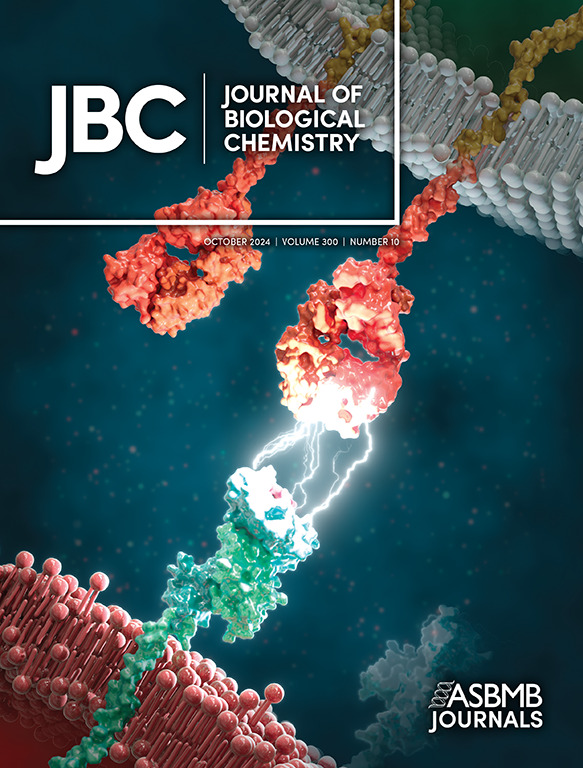酿酒酵母菌铜稳态的动力学模型。
IF 4
2区 生物学
Q2 BIOCHEMISTRY & MOLECULAR BIOLOGY
引用次数: 0
摘要
当生长在高铜环境中时,酵母细胞不是抑制铜的进入,而是输入过量的铜,同时增加金属硫蛋白CUP1的表达,然后将过量的铜隔离。建立了一个基于常微分方程的动力学模型来研究这种不寻常的行为。假设的反应网络包括酵母细胞细胞质中的25个反应和10个组分,培养基中添加了增加的营养铜浓度。假设已发表的铜蛋白和配位复合物的浓度构成低分子质量(或不稳定)的铜池。其他组分包括转录因子MAC1和ACE1, MAC1依赖性铜进口蛋白CTR1,以及其他铜蛋白。为了使足够的Cu在Cu过量的条件下进入电解槽,需要第二个与mac1无关的进口器。该数学系统在初始状态下求解了该系列中的每个条件。化学计量矩阵的零空间使用基本路径方法进行评估。计算了该系列的每个反应和每个条件下的稳态速率和速率常数。四个速率常数在整个序列中呈较高趋势,表明细胞以不包括在假设的速率定律表达式中的方式调节这些反应。这种行为是通过增加这些表达的逻辑功能来模拟的,这些表达可以感知不稳定的铜和/或营养铜。由此产生的综合动力系统近似产生了整个系列的观测到的成分浓度,并且对细胞内和细胞外的扰动都是稳定的。与mac1无关的导入物被预测为fe4,一种Cu和Fe的非特异性导入物。细胞可能会容忍过量的铜输入以输入足够的铁。本文章由计算机程序翻译,如有差异,请以英文原文为准。
A kinetic model of copper homeostasis in Saccharomyces cerevisiae.
Rather than inhibiting copper entry when grown on high Cu, yeast cells import excessive Cu while simultaneously increasing expression of metallothionein CUP1 which then sequesters the excess Cu. An ordinary-differential-equations-based kinetic model was developed to investigate this unusual behavior. The assumed reaction network included 25 reactions and 10 components in the cytosol of yeast cells growing in media supplemented with increasing nutrient COPPER concentrations. Published concentrations of copper proteins and coordination complexes that constitutes the low-molecular-mass (or labile) Cu pool were assumed. Other components included transcription factors MAC1 and ACE1, the MAC1-dependent copper importer CTR1, and other copper proteins considered collectively. A second MAC1-independent importer was required for sufficient Cu to enter the cell under Cu-excess conditions. The mathematical system was initially solved at steady-state for each condition in the series. The null-space of the stoichiometric matrix was evaluated using the Basic Pathways approach. Steady-state rates and rate-constants were calculated for each reaction and each condition of the series. Four rate-constants trended higher across the series indicating that the cell regulates those reactions in ways that were not included in the assumed rate-law expressions. This behavior was simulated by augmenting those expressions with logistical functions that sensed labile Cu and/or nutrient COPPER. The resulting integrated dynamical system approximately generated observed component concentrations over the series and was stable to both intracellular and extracellular perturbations. The MAC1-independent importer is predicted to be FET4, a nonspecific importer of both Cu and Fe. Cells likely tolerate excessive Cu import to import sufficient iron.
求助全文
通过发布文献求助,成功后即可免费获取论文全文。
去求助
来源期刊

Journal of Biological Chemistry
Biochemistry, Genetics and Molecular Biology-Biochemistry
自引率
4.20%
发文量
1233
期刊介绍:
The Journal of Biological Chemistry welcomes high-quality science that seeks to elucidate the molecular and cellular basis of biological processes. Papers published in JBC can therefore fall under the umbrellas of not only biological chemistry, chemical biology, or biochemistry, but also allied disciplines such as biophysics, systems biology, RNA biology, immunology, microbiology, neurobiology, epigenetics, computational biology, ’omics, and many more. The outcome of our focus on papers that contribute novel and important mechanistic insights, rather than on a particular topic area, is that JBC is truly a melting pot for scientists across disciplines. In addition, JBC welcomes papers that describe methods that will help scientists push their biochemical inquiries forward and resources that will be of use to the research community.
 求助内容:
求助内容: 应助结果提醒方式:
应助结果提醒方式:


